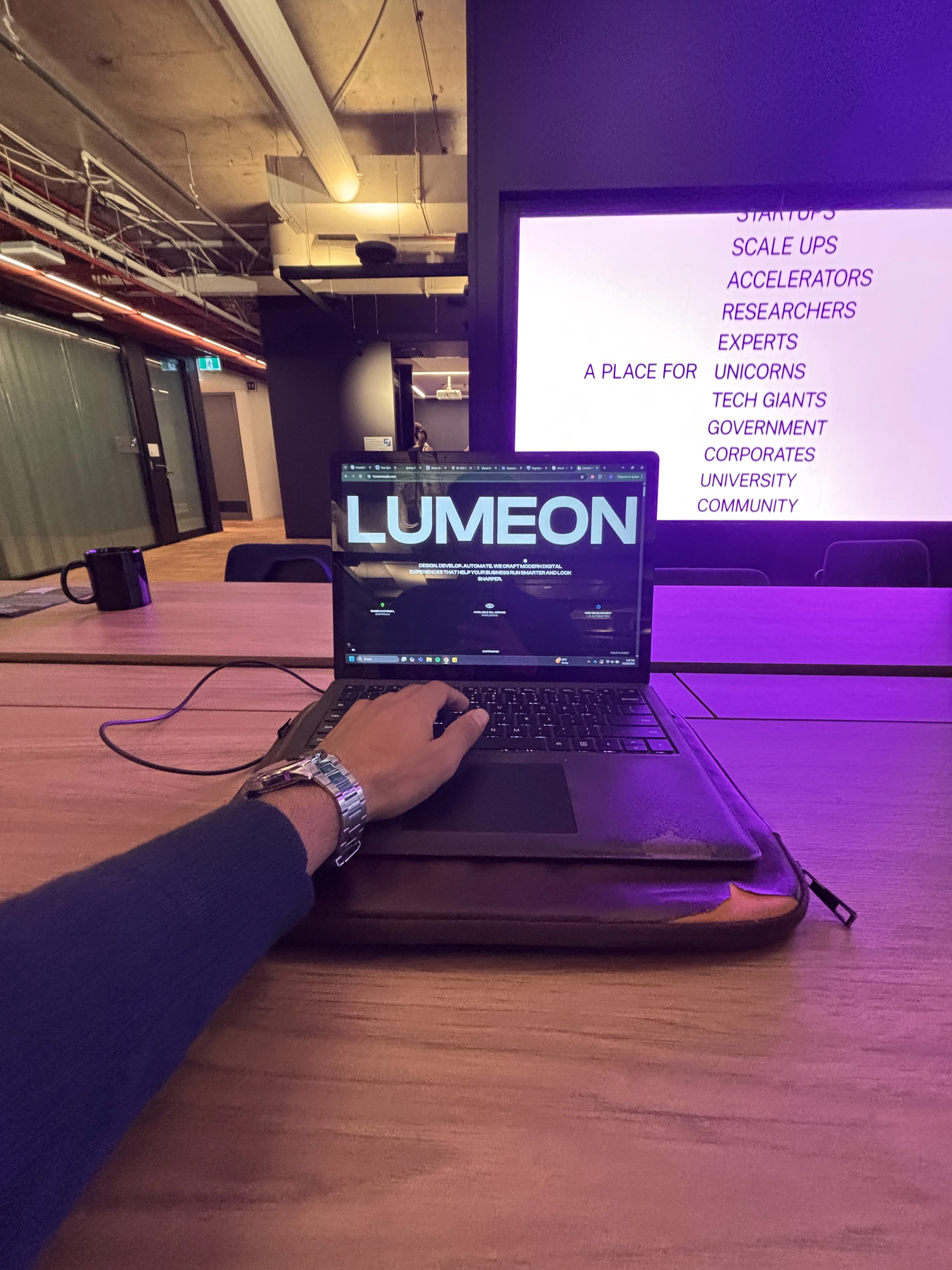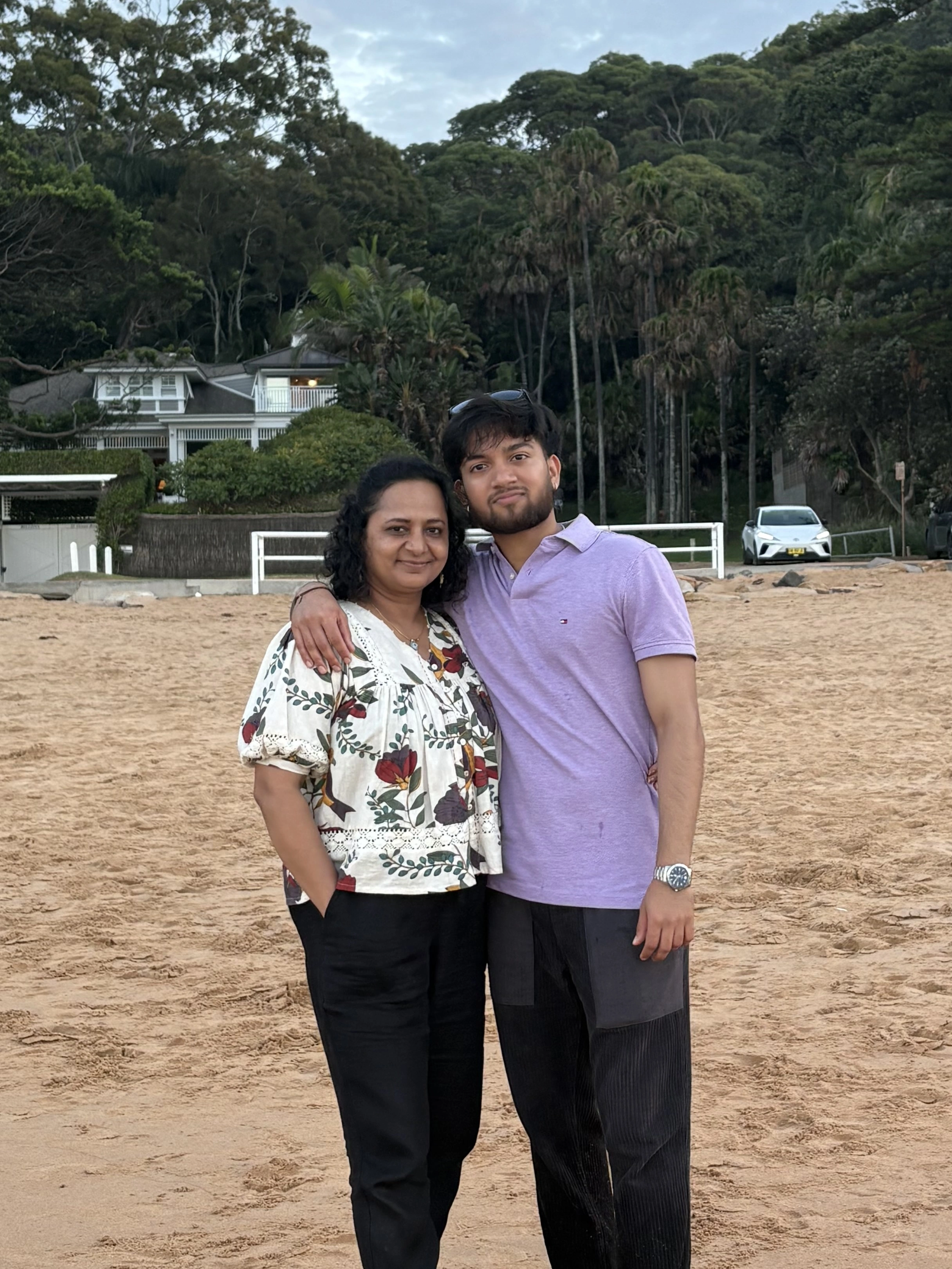Table of contents
- Haraneesh Shah
- Sydney, Australia
- Business started in 2025
- 2 Employees
- 5 figure revenue in AUD
- 300 website visitors per month
- Bootstrapped
- Lumeon Studio
Haraneesh what’s your backstory?
I was born in India and moved to Sydney when I was six. The shift was pretty full-on, learning a new language, adapting to a new culture, and honestly, I kept to myself at first, but things started looking up in high school when I got into basketball and coding, made some close mates, and picked up a few hobbies that helped me come out of my shell.

Growing up, there were some family challenges that made me step up fast and figure things out for myself. That’s probably why I leaned into tech and problem-solving; it felt like something I could control and build from scratch. Eventually, I pursued a degree in Mechatronics and Computer Science at UNSW (University of New South Wales). University has been great for learning the technical side, but the bigger leaps came from actually building stuff for people, friends, and small businesses around Sydney. Real feedback is wild, and I’ve learned a lot from both the wins and the screw-ups.

Along the way, I discovered tools like Webflow and n8n, which made it way easier to launch proper digital projects and automations. That’s basically how Lumeon Studio got started. I saw a lot of small businesses getting stuck with clunky websites and broken workflows, so I started building sites and systems that actually helped them get leads or save time.
That’s my story so far, nothing flashy, just adapting, learning, and using tech to solve real problems for people. Excited to see where life takes me next.

What is Lumeon Studio and how did you come up with the idea?
Lumeon Studio is a digital agency focused on web development and automation for businesses that want more than just a nice-looking site. The idea came from helping friends and local founders build their online setups. I kept seeing how messy things got when design and tech were handled by separate teams, and no one put much thought into automation.
Some agencies would finish a site, but it wouldn’t integrate with bookings, emails, or sales. A lot of what I did early on was cleaning up those gaps, making things actually work for the business. My background in automation and development helped me spot these issues, and it was clear there was a gap: most agencies ignored real conversion and workflows.
What keeps me focused is seeing actual impact, such as clients getting more leads, saving time, or finally having a system that works for them, not against them. Lumeon is all about keeping it simple, solving the real problems, and making sure everything connects for business growth.

How did you acquire your first 10 clients, and what strategies worked?
My first clients came mostly through consistent outreach on LinkedIn, sharing real results, and being super transparent. I made a point to send personalised cold messages, not just generic templates. Before reaching out, I’d research the person and their business, figure out what they actually needed, and mention a specific problem I could solve. That stood out in people’s inboxes because it was relevant and showed I paid attention.
I always attached proof, like quick Loom videos, screenshots, or mini case studies that showed the impact I’d had for past clients. Following up was essential too. I’d usually send the first cold message, then two follow-ups spaced a few days apart, each time adding a bit more context or a new angle on how I could help.
Referrals and word of mouth made a big difference as well. After delivering for my early clients, most ended up recommending me to their network or tagging me when someone asked about web or automation work. Referrals go a long way; so it’s important to deliver more than what you promised.
Now, I’m building out automated email marketing sequences to supplement cold outreach and widen my reach. I’m using what I’ve learned from LinkedIn to make sure the emails feel personal, relevant, and actionable, not spam. If anyone wants to talk about how to set this kind of system up or roll it out for their own business, feel free to reach out. I’m always keen to share what’s working and help others skip the trial and error.
What feedback did you get from your first clients, and how did you iterate based on this?
Honestly, at the start, I was completely new to working with clients and made plenty of mistakes. My communication was shaky, I didn’t have clear project frameworks, and I didn’t set proper deadlines. There was a lot of just winging it and hoping things would work out.
The most common feedback was the need for better communication, clear timelines, and updates. Clients wanted to know what was happening, when to expect results, and how any issues would be handled. I realized quickly that just being good technically wasn’t enough; people wanted reliability and felt uneasy if things weren’t organized.
To fix this, I introduced proper onboarding, set clear expectations and deliverables right from the start, and started using tools like Notion to keep projects visible. I made it a habit to send daily or weekly email updates, depending on the client’s preference, and always checked in about any blockers early.
There were challenges. Sometimes I’d over-promise on timelines without knowing the real workload involved, which meant learning to estimate better and sometimes admitting when I was wrong. Getting feedback stung a bit at first, but over time, I realized it was all about building trust. Each time a client pointed out something that could be improved, I made sure to solve it and not repeat the mistake next time, whether it was better handover docs, walking through automation setups, or updating them on the next steps.
These systems and habits have made a massive difference. The client experience is way smoother, and word of mouth spread faster once people saw I could deliver and communicate well. Now, every project gets a proper kick-off, structured updates, and clear ways to flag problems early, so nothing lingers.
If you’re curious, you can check out the feedback and reviews on my LinkedIn or website. Making these changes has directly led to higher client satisfaction and way more repeat business. The process isn’t always smooth, but adapting fast and actually listening has paid off.

Which channels have been most effective in reaching your clients, and how did you find them?
LinkedIn has easily been the most effective channel for client acquisition and networking. The goal is to get as many eyeballs on your profile and website as possible. Here’s what works:
- Engage with creators by liking and commenting on posts, but only on stuff that actually resonates.
- Max out your connect requests. If someone likes your post, their connections see it – it compounds.
- Don’t just connect, reach out to people you admire. If you ask nicely, most people are willing to help.
- Create valuable content, share your thoughts, inspire people, and join industry groups.
Now I’m implementing cold email marketing systems, so let’s see how that pans out.
Digital agencies are competitive, what’s your top tip for standing out?
I’m nowhere near where I want to be, but if you want to stand out, you’ve got to show clear, measurable impact - not just technical skills. At Lumeon Studio, that means proving increased conversions, streamlined workflows, and tangible business outcomes for every client. Systematizing project delivery and being open about both wins and lessons learned helps, too. Also, specialize in an industry; if you focus on a niche, more people from that space will reach out because you cater specifically to them.
What inspired you to merge design and development in one studio?
Businesses hit roadblocks when design and development are separated. Integrating the two means more cohesive, user-centric solutions, and avoids delays from miscommunication. Lumeon Studio is based on combining creative and technical work to serve the same goals, so clients get results that not only look good but drive real business outcomes. Plus, I just enjoy doing both, honestly.

How do you manage client relationships and ensure repeat business?
Honestly, I learned a lot about communication and building good relationships from my mum. She’s always been great with people, and watching her made me realise how important it is to be likeable and genuine, no matter who you’re dealing with.
That’s shaped how I work with clients at Lumeon Studio. After we launch a project, I stick around for at least a month to help them sort out any issues and make sure everything’s running smoothly. For me, it’s more than just finishing the job; I actually want them to get results and succeed.
Putting in that extra effort is what gets repeat clients and referrals. I’m not just trying to tick boxes; I’m here to add real value and make sure my clients feel supported, which is how you build long-term partnerships.
How did you expand internationally, and what advice would you give to others doing the same?
I’ve only had one international client, and that was through LinkedIn. They liked my work. It’s not that I avoid international clients; I just haven’t gotten around to specifically reaching out overseas.
If you want to land international clients, start by posting your work and sharing your story. It’s difficult to get a foot in the door if you’re not local, so building a personal brand and content presence is key. Keep your work high quality, stay responsive across time zones, and showcase your results.
I think it makes sense to establish yourself locally first, then go global.
What’s it like running Lumeon Studio as a solopreneur?
It’s tough, but that’s also what makes it super rewarding. I handle everything - marketing, sales, project delivery, and yeah, it can get intense. It demands commitment and resilience, but it gives me full ownership over the direction and quality of everything we do. Right now, I’m all about learning as much as possible, as fast as possible, and doing everything myself is the best way to do that.
What are your plans for Lumeon Studio in the future?
Honestly, still figuring things out since it's early days, but I have a few ideas. I want to build scalable solutions, tap into new markets internationally, and if things go as planned, maybe create a product someday. Who knows, but it doesn’t hurt to dream big.
What specific tools, software, or resources have been most helpful in growing Lumeon Studio?
These are the main tools we use at Lumeon:
What’s your top advice for web design founders aiming to grow and find product-market fit?
Ship real solutions and get fast, honest feedback. Building in public is incredibly valuable these days. Talk to prospects and test, refine your offer based on what clients actually need. Set up clear processes, deliver results you can measure, and let your work do the talking. If you provide genuine value, success will follow, just keep at it.
Any promotions you would like to add for Founderoo readers?
If you found us through Founderoo, just mention it when you reach out, and you’ll get 20% off any service at Lumeon Studio.
What drives you to do what you do?
What drives me is the belief that I can genuinely make an impact on the world and the people around me. Building technology and design solutions isn’t just work for me, it’s something I genuinely love doing and happens to be a skill I’m good at, so using it as a medium to help others just makes sense.
One of my core philosophies is to leave the world better than I found it. For me, it’s all about making as big a difference in other people’s lives as I can. In the end, it’s not about money, wealth, or fame - people will remember the impact you had on them. That’s what fuels me every day, using what I enjoy and what I’m good at to create meaningful, positive change for others.
Any quotes or philosophies you live by?
“Just be a good, kind human being.”

%20Logo.svg)




